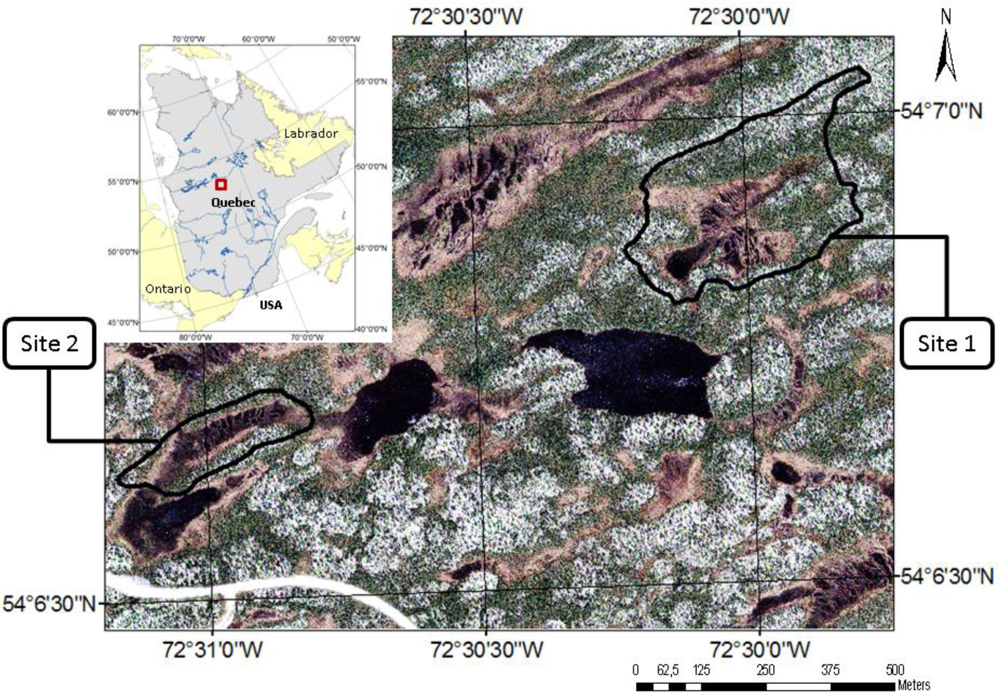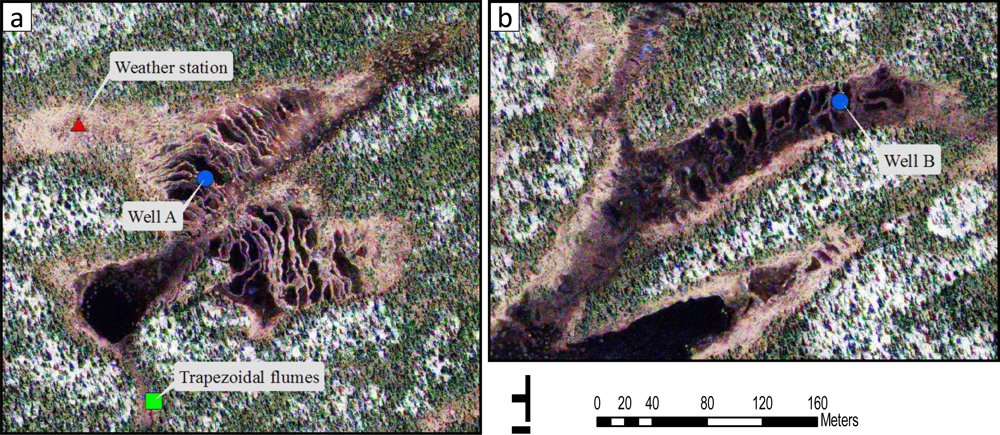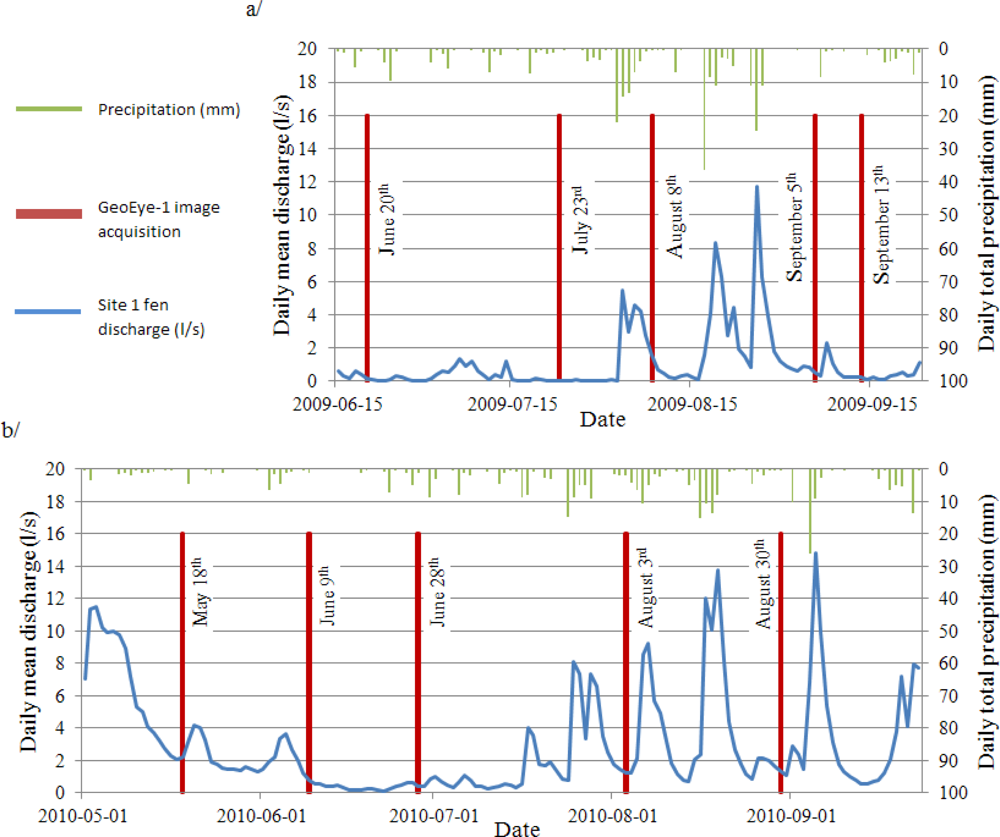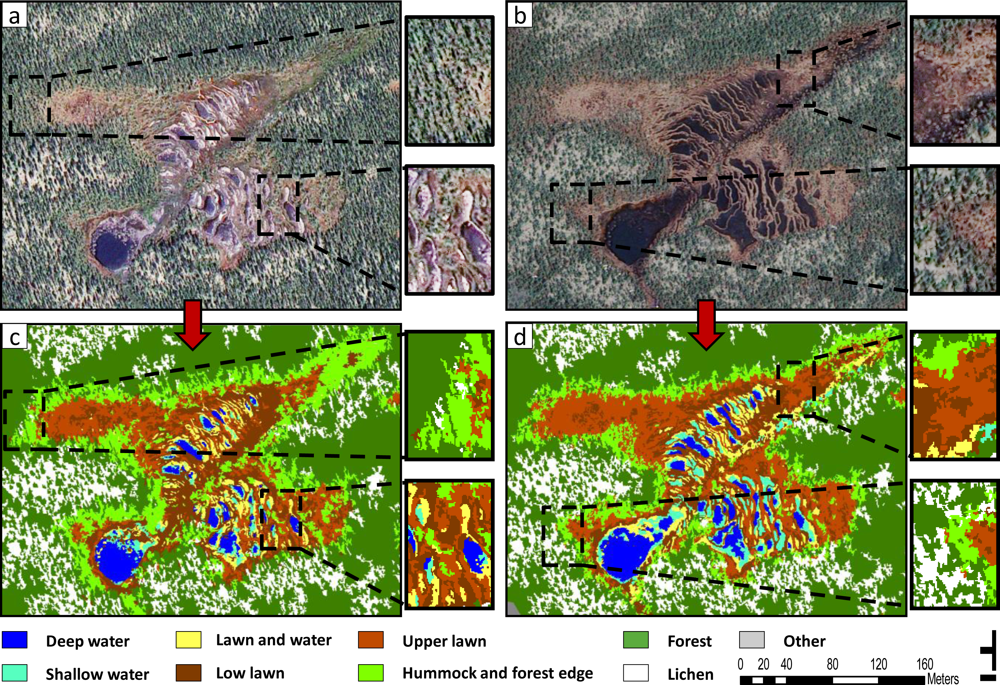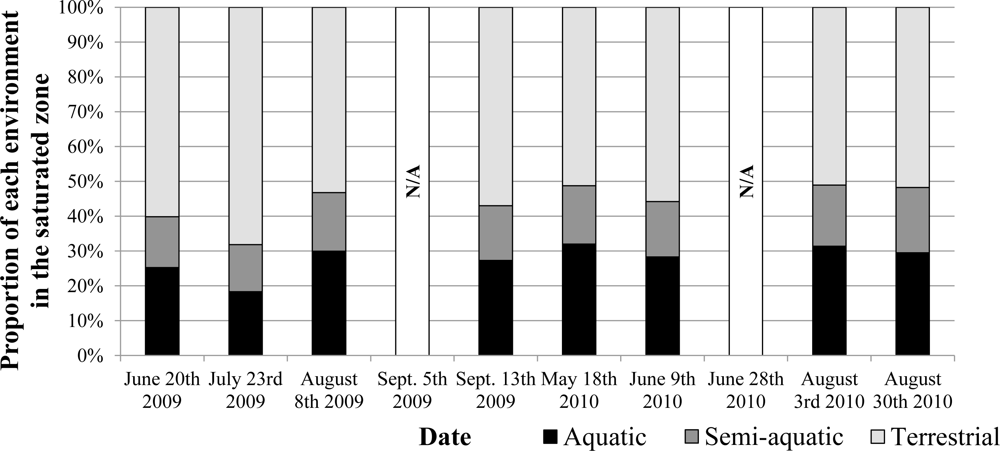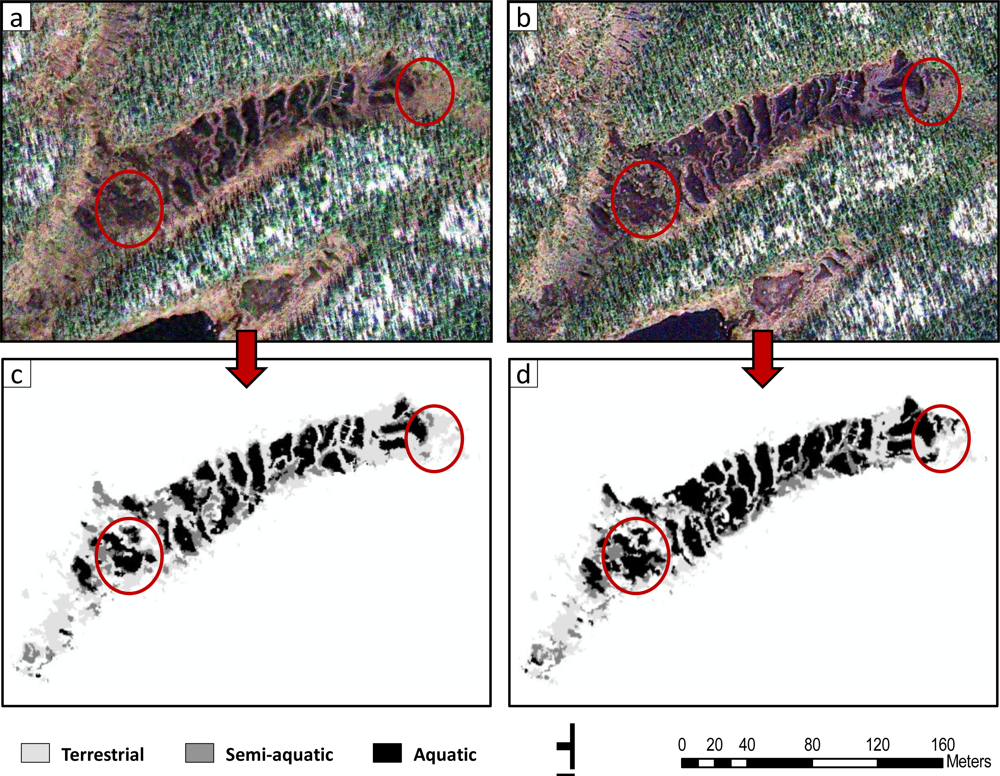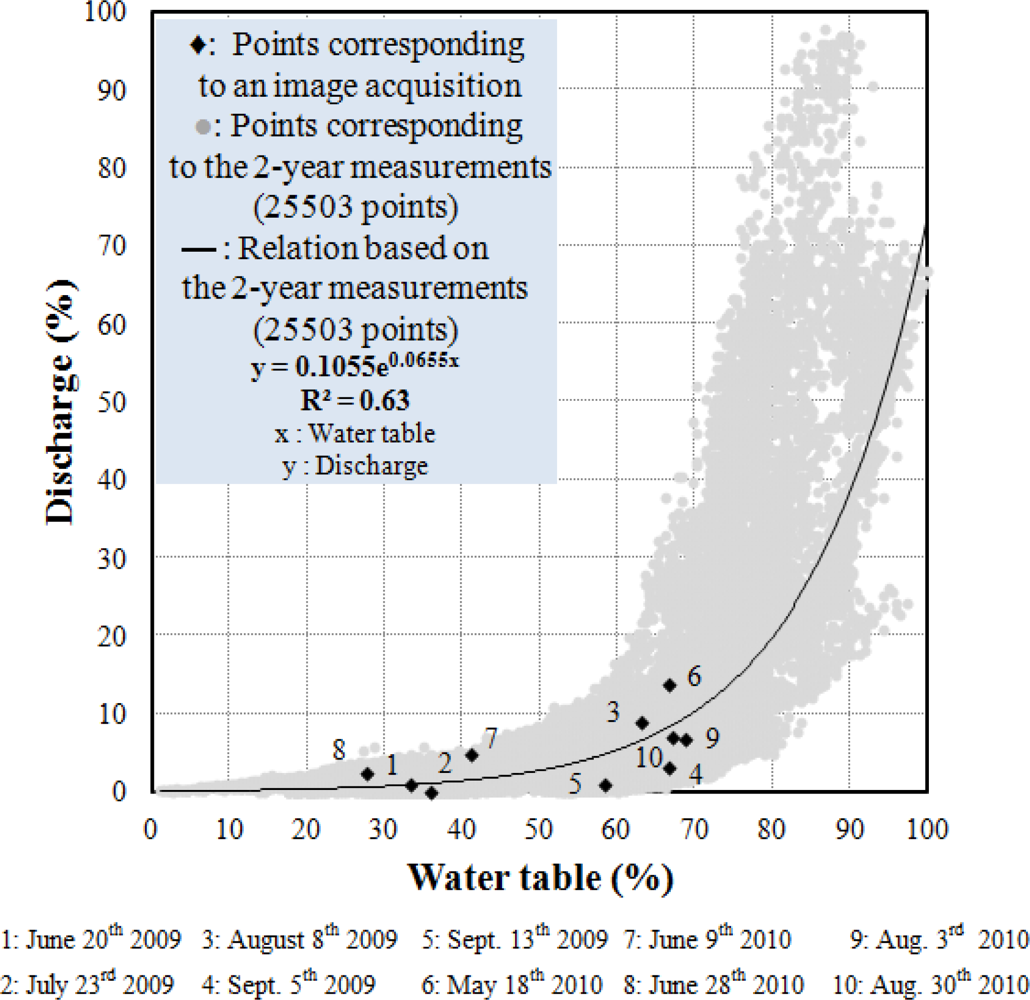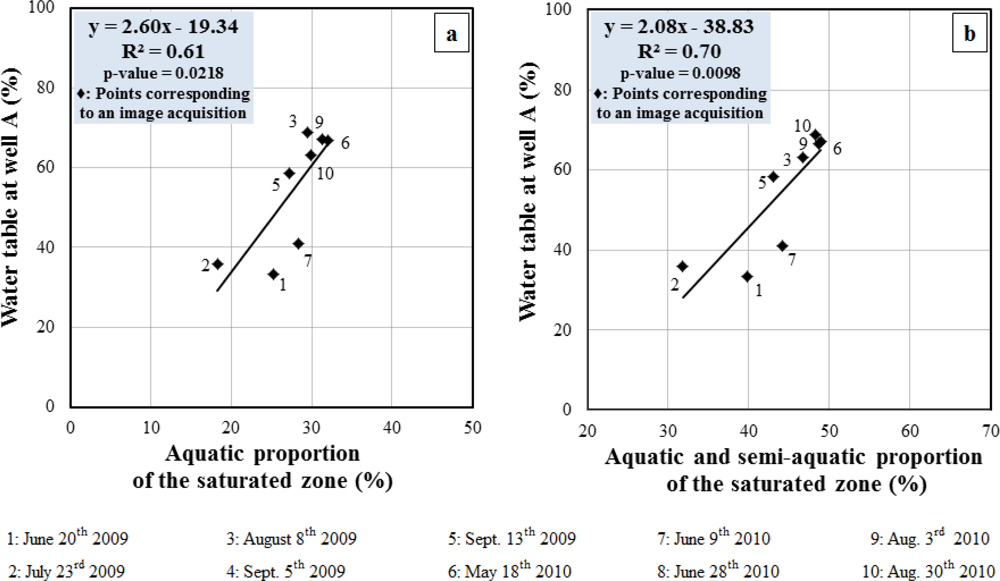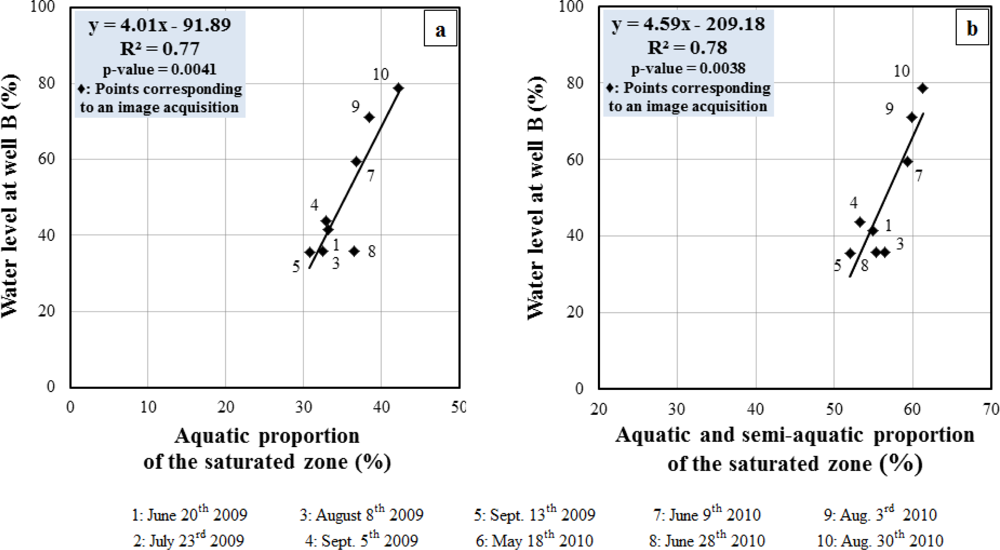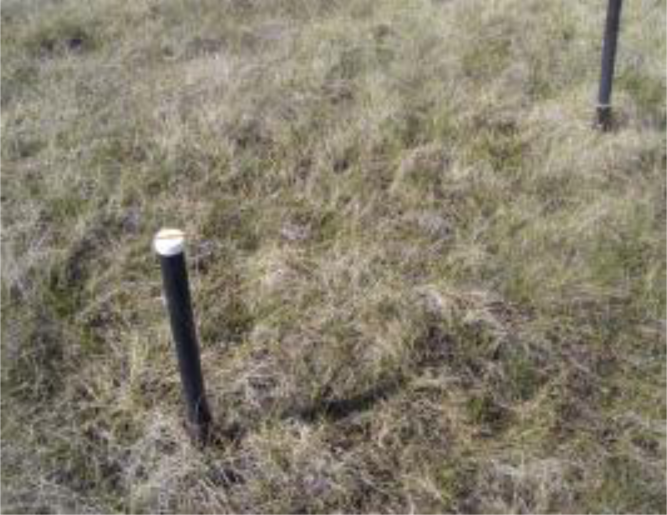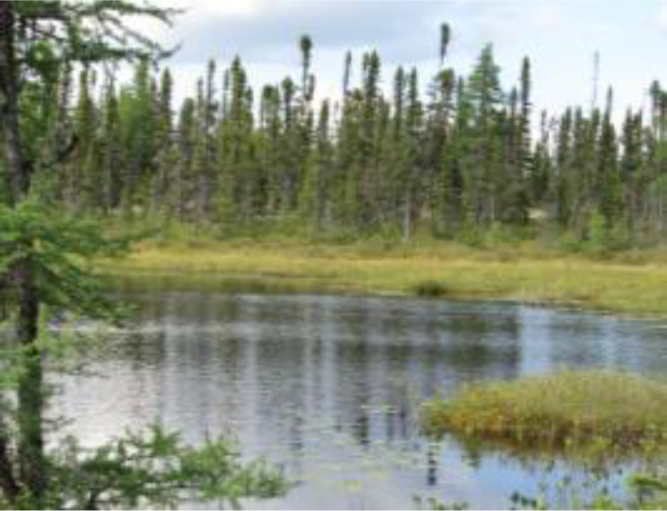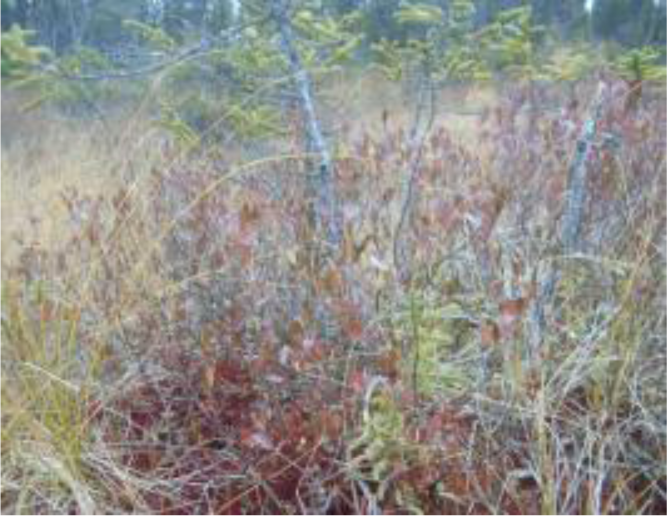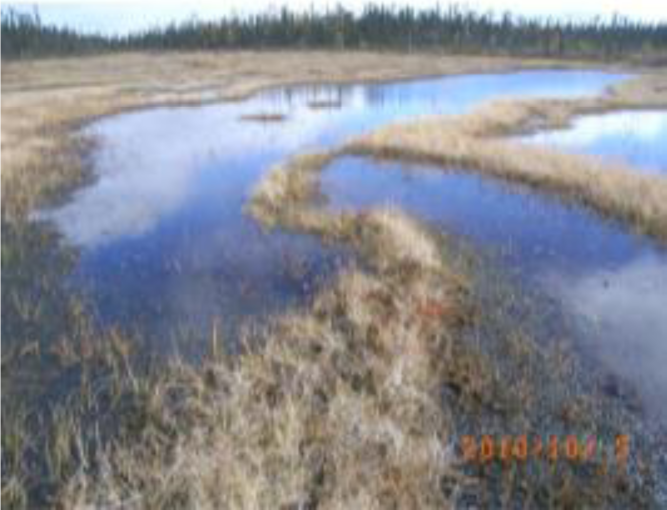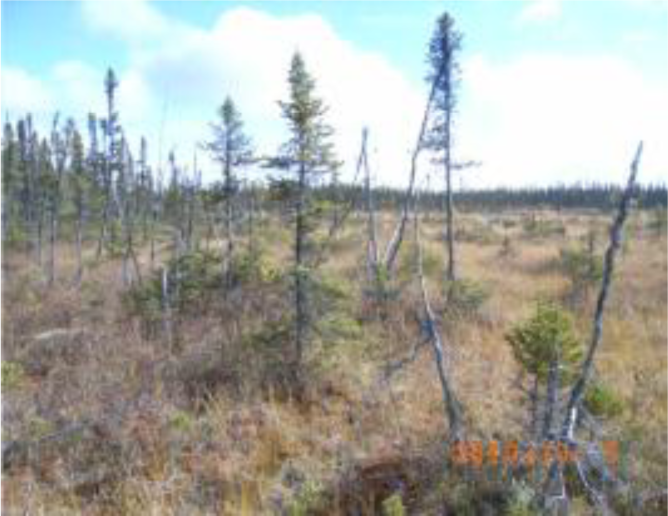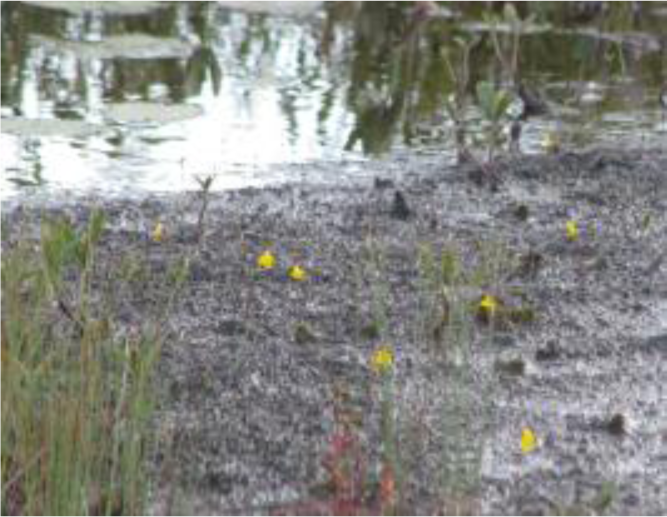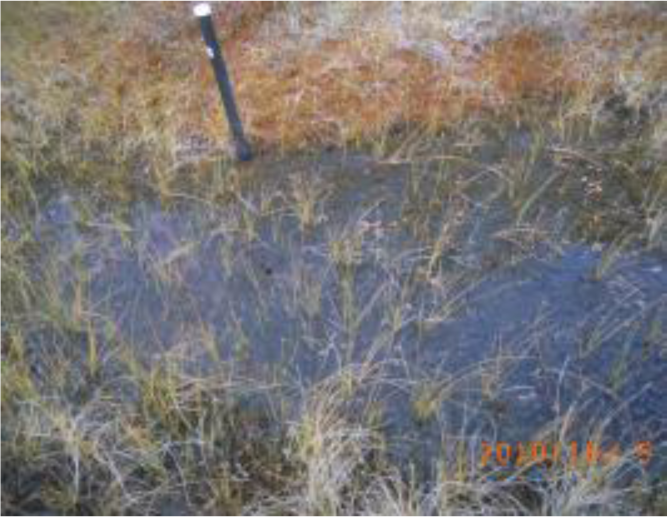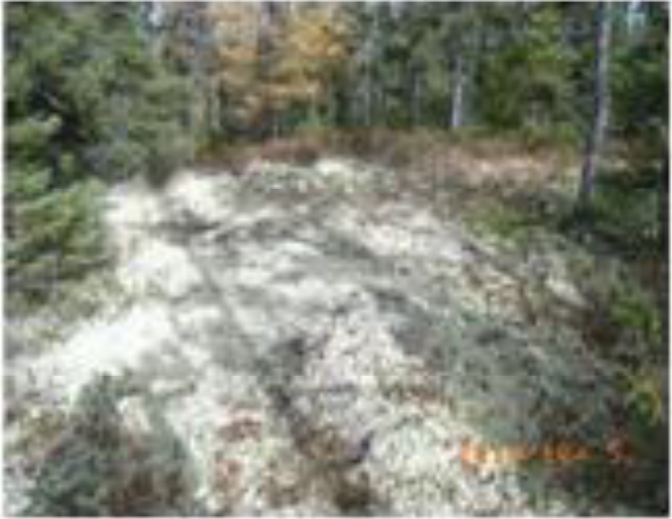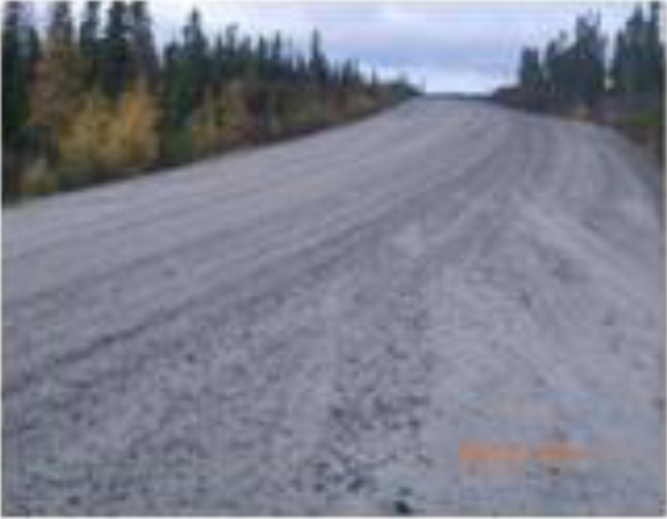3.1. Object-Based Image Classification
Two GeoEye-1 image subsets centered on site 1 are shown in
Figure 5 with their respective fine-scale classifications. These subsets were chosen because the hydrological conditions (in particular, the discharge values) they recorded, differed greatly. The white and grey zones in the 23 July 2009 image were caused by sunglint, which separated the “shallow water” and the “lawn and water” from the other environments (
Figure 5(a,c)). Visual correspondence between the two classifications and the two RGB images was very good. Most of the errors appeared on the border of the site 1 fen (caused by non-restrictive rule sets applied to the “transition” class), where they had no effect on the results of the hydrological study (
Figure 5(a–d)). Misclassifications appeared also on the 18 May 2010 image due to the phenological stage of shrub vegetation. Many hummocks were classified as “upper lawn” or “low lawn”, (
Figure 5(b,d)) since shrubs on these hummocks were not green at this season and discriminant features were based on greenness indices.
Classification accuracy was assessed using the confusion matrix method. The classification accuracy results of the 9 June 2010 image (coarse scale: Step 2), used as the reference image, are given in
Table 3 and
Table 4. The confusion matrix in
Table 3 shows the accuracy results of the original classes, while the matrix in
Table 4 shows the accuracy results of environmental groupings (
Table 2) of the original classes. The overall accuracy of the original classes was 86% and the Kappa coefficient was 84% (
Table 3). The majority of misclassifications appearing in this first matrix were not relevant. The confusion matrix based on environmental groupings gave better results, showing an overall accuracy of 93% and a Kappa coefficient of 90%. This ensured high accuracies for the subsequent fine classifications of all 10 images, avoiding most of the error propagation due to class-related hierarchical features. The most important issue was confusion between objects in the FOREST group and objects in the PEAT group (32 out of 554 objects in these groups). To manage this imperfect delineation of peatlands, a “transition” class was created (coarse scale: Step 3) after the first classification of the 9 June 2010 image. The transition area was then reclassified at a finer scale (Step 8) as either forest or peatland.
The fine-scale classification accuracy results of the 10 images (Step 8) are given in
Tables 5 and
6.
Table 5 shows the accuracy results of the original classes.
Table 6 shows those of hydrological groupings of the original classes. The groupings were functions of the saturation degree (aquatic, semi-aquatic, terrestrial) of the classes. These groupings were very helpful for monitoring the seasonal spatial dynamics of the hydrology at the study sites. The “open water” and “shallow water” classes were included in the AQUATIC group, the “lawn and water” class was included in the SEMI-AQUATIC group, and the remaining classes were included in the TERRESTRIAL group.
The classifications of the original classes had an overall accuracy of 82% and a kappa coefficient of 79% (
Table 5). This high level of accuracy indicates the robustness of the specific object-based rulesets developed in order to investigate the hydrological dynamics at an intra-seasonal scale with multispectral imagery. The “open water”, “upper lawn”, and “lichen” classes were well-classified since their spectral features were easily distinguishable. However, some significant confusion can be observed between the other classes. The producer’s accuracies of the “forest” and “hummock and forest edge” classes were under 70%. Moreover, the user’s accuracies of the “shallow water”, “lawn and water”, and “low lawn” classes were under 75%. Since the transition area between peatland and forest was reclassified at a fine scale, it was considered in the confusion matrices. This transition area is a highly heterogeneous environment (containing peat, shrubs, trees, and their shadows) with non-restrictive applied rulesets. Thus, very small objects were generated, which sometimes caused classification problems. For example, objects corresponding to tree shadows were easily misclassified as “shallow water” since they were spectrally homogeneous and dark.
The accuracy results of the hydrological groupings were higher, with an overall accuracy of 92% and a kappa coefficient of 83% (
Table 6). The accuracy of the SEMI-AQUATIC group was lower than those of the AQUATIC and TERRESTRIAL groups. This can be explained by the nature of the SEMI-AQUATIC group, which was created from a single class and represents a transitory environment. The producer’s accuracies of the AQUATIC and SEMI-AQUATIC groups were 97% and 84%, respectively. These results indicate a low level of omission error, which means that the majority of the aquatic and semi-aquatic compartments of the peatlands were detected effectively in the satellite images. Such accuracies were necessary in order to study the spatial dynamics of these compartments (see Section 3.2). The user’s accuracies of the AQUATIC and SEMI-AQUATIC groups were 87% and 64%, respectively. These results indicate a higher level of commission error, leading to overestimation of the area of the aquatic and semi-aquatic compartments. A significant number of TERRESTRIAL objects were misclassified as SEMI-AQUATIC (216 objects) or AQUATIC objects (116 objects). These TERRESTRIAL objects were most often “forest” or “hummock and forest edge” objects (
Table 5). The overestimation of the area of the aquatic and semi-aquatic compartments was not critical for our further study of the spatial dynamics of these compartments. Indeed, the heterogeneous environment of the transition area, where most of the confusion appeared, remains outside the limits of the later defined saturation area (see Section 3.2).
3.2. Seasonal Spatial Dynamics of Aquatic and Semi-Aquatic Structures in Fens
In order to study the evolution of the hydrology of the peatlands, the saturated zone was delineated for both peatlands. This zone includes the terrestrial, semi-aquatic, and aquatic compartments, which are spatially dynamic. The saturated zone is affected by the presence of water at or near the surface (<10 cm deep), which influences the composition of its vegetation cover [
40]. The following classes were considered as saturated: “low lawn”, “lawn and water”, “shallow water”, and “deep water”. The 3 August 2010 classification map was chosen to delineate the saturated zone in both fens under study. This map was chosen because green vegetation (high contrast with saturated peat) and wet conditions enabled precise delineation of the saturated zone (
Figure 6).
Within the site 1 saturated zone, the aquatic (“open water” and “shallow water” classes), semi-aquatic (“lawn and water” class), and terrestrial proportions were calculated from the 10 image classifications; these proportions are shown in
Figure 7. The results demonstrate the existence of significant seasonal spatial dynamics of the compartments. The aquatic proportion of the saturated zone varied between 18% at the driest conditions observed (23 July 2009: no precipitation, snowmelt ended, high evapotranspiration rate) and 32% at the wettest period observed (18 May 2010: snowmelt, low evapotranspiration rate), corresponding to an increase of 78%. The increase in the combined aquatic and semi-aquatic proportions of the saturated zone was 53% (from 32% to 49%). As shown in
Figure 8 (encircled features), between the driest and the wettest conditions observed, strong spatial dynamics occurred upstream of the largest pool at the outlet of the site 1 fen. The north-eastern part of the fen (upstream) was also subject to significant spatial dynamics, with temporary pools appearing on the 18 May 2010 image.
Within the site 2 saturated zone, significant seasonal spatial dynamics of the compartments was also noticed (
Figure 9), but of smaller magnitude. Unfortunately, there were clouds over site 2 on 23 July 2009 and 18 May 2010, the respective dates on which the driest and the wettest conditions were observed at site 1. Thus, the amplitude of the seasonal spatial dynamics cannot be directly compared between the two sites. The aquatic proportion of the site 2 saturated zone varied between 31% at the driest conditions observed (13 September 2009: no precipitation, snowmelt ended) and 42% at the wettest period observed (30 August 2010: precipitation, low evapotranspiration rate), corresponding to an increase of 35%. The increase in the combined aquatic and semi-aquatic proportions of the saturated zone was 17% (from 52% to 61%). As shown in
Figure 10 (encircled features), between the driest and the wettest conditions observed, strong spatial dynamics occurred on the edges of some of the main pools. The eastern part of the fen (downstream) was also subject to significant spatial dynamics, with temporary pools appearing on the 30 August 2010 image.
3.3. Seasonal Spatial Dynamics in Relation to the Hydrological Regime of Fens
Figure 11 shows the relationship between the water table level measured at well A and the discharge measured at the outlet of the site 1 fen. The water table data is of course derived from a local measurement, whereas discharge measure is the consequence of runoff in the whole fen watershed. We assumed, however, that water table changes were relatively homogeneous throughout each site. On
Figure 11, each point corresponds to a pair of water table and discharge measurements taken at 15-min intervals during the 2009 and 2010 snow-free seasons. The range of measured values is displayed in percentages to facilitate comparison with subsequent graphs. These percentages were calculated relative to the maximal water table and discharge values during the two-year period.
An exponential relation was found between water table and discharge values, similar to the one reported in previous hydrological studies on patterned peatlands [
9,
11,
47], with a coefficient of determination of 0.63. Two phases can be distinguished in the evolution of discharge values relative to the water table. In the first phase, the water table rises rapidly but discharge remains low. For example, the water level may equal 60% of the maximal measured water level while the corresponding discharge is equal to only 5% of the maximal measured discharge. In this phase, the incoming water contributes to an increase in the water level in the fen but not to a significant evolution of the discharge: it is a storage phase. In the second phase, the water level is already high and does not increase much but there is a sharp increase in discharge from the fen: this phase is a runoff phase. For the purposes of modeling this regime, it is particularly important to identify the threshold on the relation where the regime phase changes. Since heavy rainfall can lead to heavy runoff in one phase and no runoff in the other phase, successful modeling of hydrological behavior in fens hinges on distinction of the two phases [
47]. However, water table values often vary as much as 30% for a given value of discharge. This high dispersion of water table values may be explained by a hysteresis effect [
11,
48]. Depending on whether the runoff significantly increases or significantly decreases, the relation between water table and discharge reacts slightly differently. This creates some uncertainties for modeling of the regime phases and thus needs to be considered.
In situ hydrometric measurements taken at the same time as the satellite images used in this project are highlighted in
Figure 11. The GeoEye-1 images were acquired during varying hydrological conditions, at the beginning and the end of the storage phase. Among the acquired images, the driest hydrological conditions (corresponding to the beginning of the storage phase) occurred on 20 June 2009, 23 July 2009, 28 June 2010, and 9 June 2010. The dry hydrological conditions on these dates resulted from the long duration of the day and high temperatures experienced during the months of June and July [
28]. These conditions imply a higher evapotranspiration rate in peatlands. By this time of year, the snowmelt had also ended. The remaining 6 images were acquired during wetter hydrological conditions corresponding to the end of the storage phase. These images were acquired in May, August, and September 2009 and 2010. In May, the snowmelt often produces wet hydrological conditions in peatlands [
49]. In August and September, the days shorten and mean temperature falls [
28], causing a relatively low evapotranspiration rate [
40]. Unfortunately, for reasons explained in Section 2.3.1 no image was acquired during the runoff phase. Nevertheless, as seen in Section 3.2, our satellite image classifications showed that the seasonal spatial dynamics of aquatic and semi-aquatic structures in the fens was substantial. The lack of images of high discharge events was not an obstacle to observation of the seasonal hydrological dynamics. These dynamics were considerable during the storage phase and seemed to be related to the evolution of the water level.
In the following analysis, links between the evolution of the measured water levels and the spatial dynamics of the aquatic and semi-aquatic compartments were assessed. The aquatic compartments of the saturated zone could have been chosen as the only indicators of the spatial dynamics of the hydrology of the sites. We chose to include the semi-aquatic compartments as well, as they play an integral part in these dynamics. We must remain cautious about this inclusion, however, since the results of the last confusion matrix (
Table 6) showed that the SEMI-AQUATIC group was less precisely classified than the other groups.
Figure 12 shows the water table variation measured in site 1 compared to the spatial variation of the aquatic and semi-aquatic compartments within site 1 (derived from eight GeoEye-1 classifications). Linear correlations were established in all cases. Over 60% of the water table variation was explained by the spatial variation of the aquatic and semi-aquatic compartments. These correlations were significant with a
p-value < 0.05. The slope of the linear functions was always positive. This implies that higher “aquatic” and “aquatic and semi-aquatic” proportions of the saturated zone indicate a higher water table. This result enabled us to validate once more the precision of the performed classifications and their relevance for tracking real hydrological variations.
However, as noted above, the water table data are derived from a local measurement (a single point), while the classification-derived results describe the whole saturated zone of the fen. The dynamics of the water table can vary at different locations in a single fen. This may explain why the points differ so much from the linear model on some dates (20 June 2009, 9 June 2010).
Figure 13 shows the water level variation measured in site 2 compared to the spatial variation of the aquatic and semi-aquatic compartments within site 2 (derived from eight GeoEye-1 classifications). Linear correlations were established in all cases. Over 75% of the water level variation was explained by the spatial variation of the aquatic and semi-aquatic compartments. These correlations were significant with a
p-value < 0.05. The slope of the linear functions was always positive. As for the site 1 fen, this relation implies that higher “aquatic” and “aquatic and semi-aquatic” proportions of the saturated zone indicate a higher water level. This result also enabled us to validate the precision of the performed classifications and their relevance for tracking real hydrological variations.
There was a significant difference between the R2 values of the water levels measured in well A and those measured in well B. R2 was always lower in the first case than in the second case. This difference may be explained by the different types of measurements made. Groundwater level (under the lawn surface) was measured at well A, whereas open water level (at the pool surface) was measured at well B. The statistics derived from the classifications were related to hydrological variations at the surface of the fen and should therefore be better correlated with the evolution of pool water levels than with that of groundwater levels.
The slopes of the linear relations in
Figure 13 (site 2 fen) are around two times steeper than those in
Figure 12 (site 1 fen), reflecting weaker spatial dynamics of the aquatic and semi-aquatic compartments in the site 2 fen. The internal structures of the fens undoubtedly influence these slopes. Morphological features such as pool area, pool depth, and pool outlines provide some indication of the structure of the peatland [
50]. We hypothesize that well-defined pool outlines indicate insignificant spatial dynamics in the aquatic and semi-aquatic compartments. Loose outlines, on the other hand, suggest major spatial dynamics in the aquatic and semi-aquatic compartments. In the latter case, the incoming water cannot be stored vertically in the pool, so it spreads horizontally, which explains why the aquatic and semi-aquatic spatial dynamics appear in the imagery. To assess this hypothesis, a comparison between the pools of the two sites was made. The pools are generally large on site 2 (
Figure 10), whereas the proportion of large and small pools is more balanced on site 1 (
Figure 8). White found a positive correlation between pool area and pool depth [
50]. The same study also found that pools with a sharp contour were significantly larger than those with a loose outline [
50]. Overall, small pools tended to be shallow and to have a loose outline, while large pools tended to be deep and to have a sharp outline. Our hypothesis suggests that these characteristics should lead to stronger aquatic and semi-aquatic spatial dynamics at site 1 than at site 2. However, the strong dynamics observed at site 1 were caused by more than just the presence of small pools with loose outlines. As noted above, a very large pool near the outlet of the site 1 fen also made major contributions (
Figure 8). Water tends to be stored downslope in the fen [
50]. Large amounts of water coming irregularly from the two wings of the fen induced the strong spatial dynamics upstream of the pool. To better understand the degree to which various morphological parameters (pool area, depth, outlines) influence the magnitude of increases in the proportion of aquatic and semi-aquatic compartments, more sites with very different morphological features should be monitored in the future.
